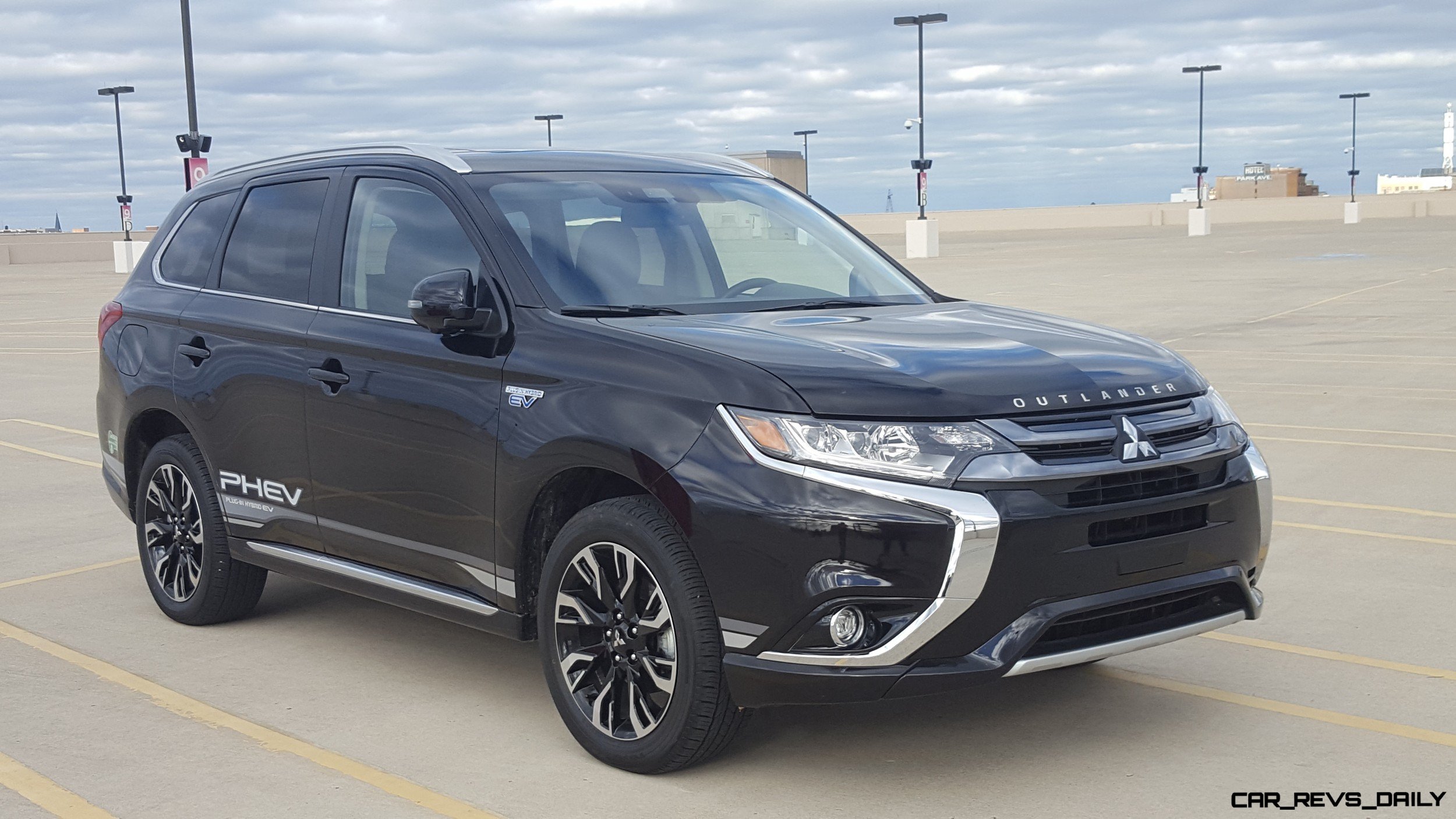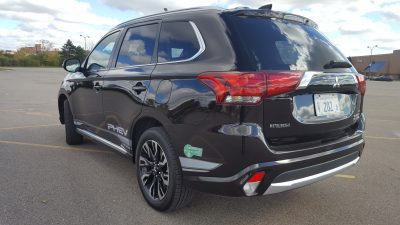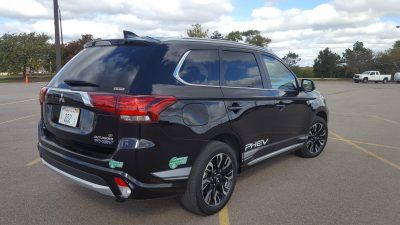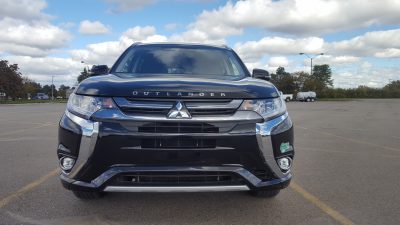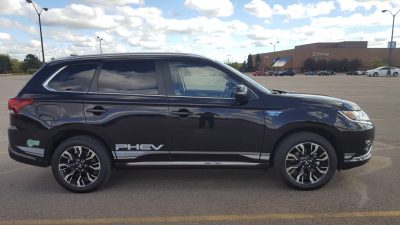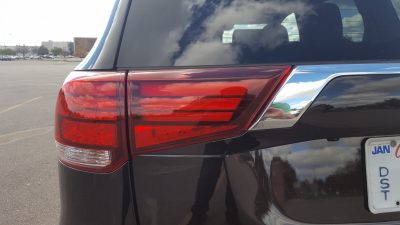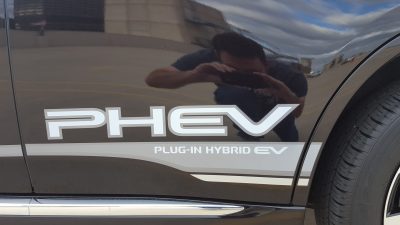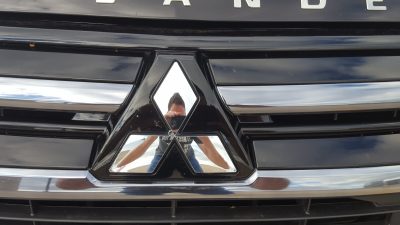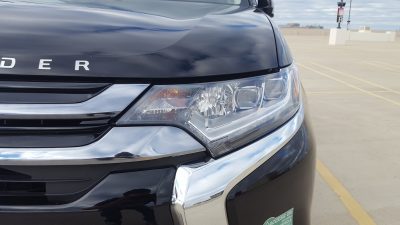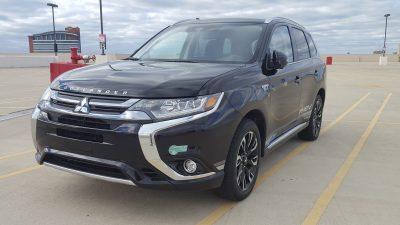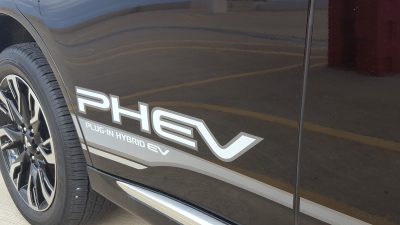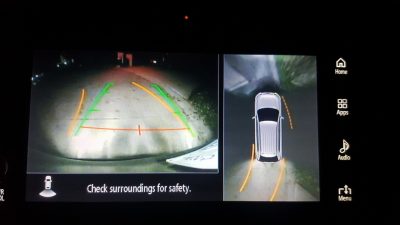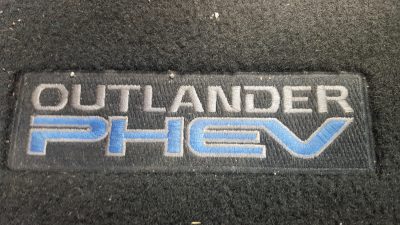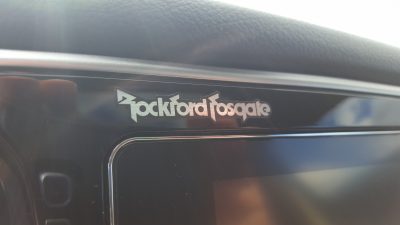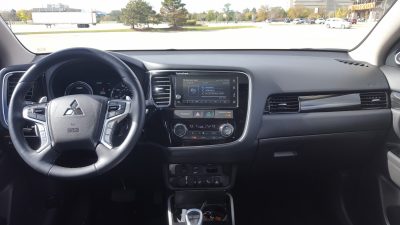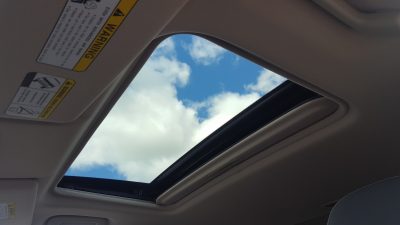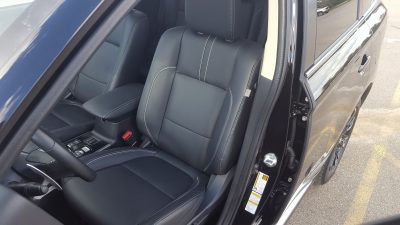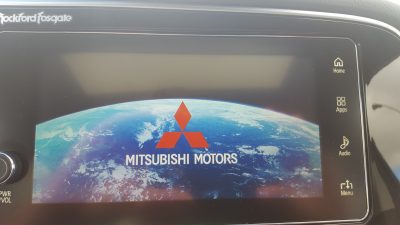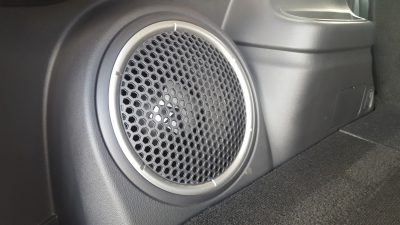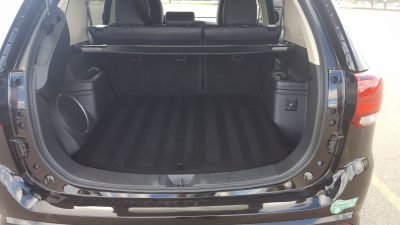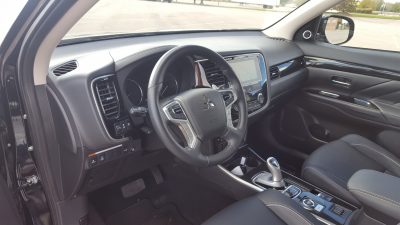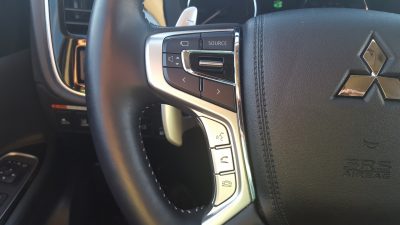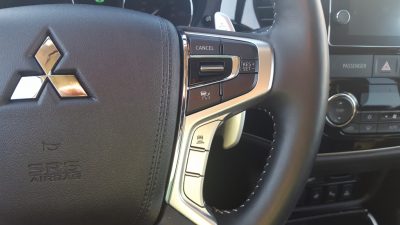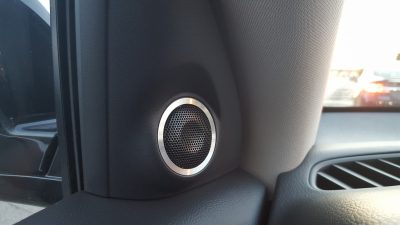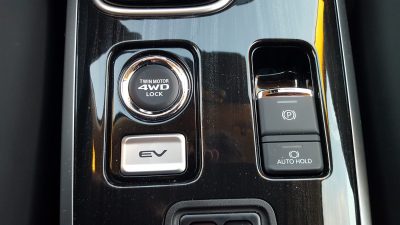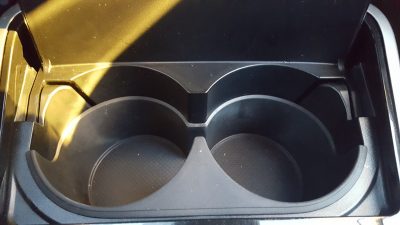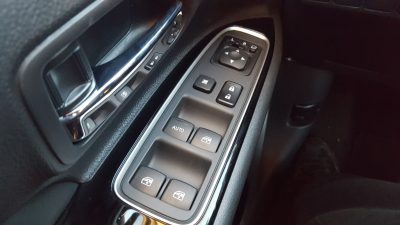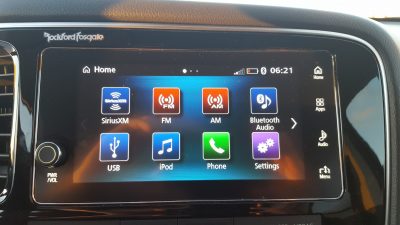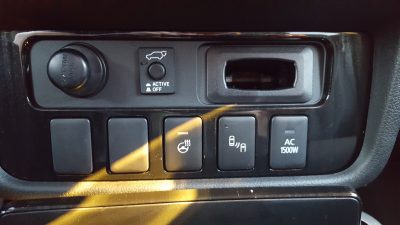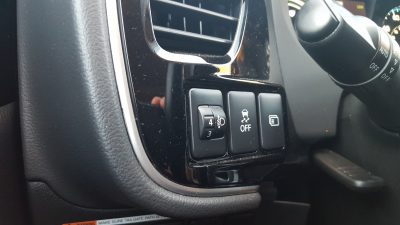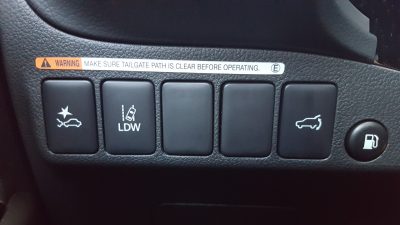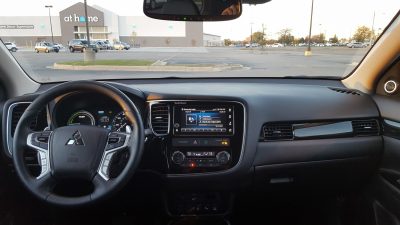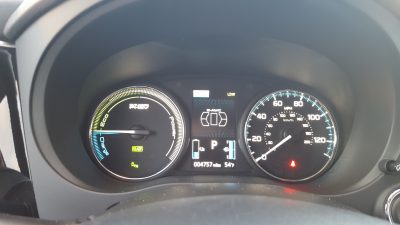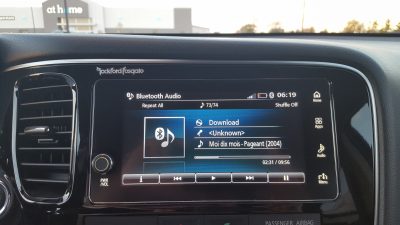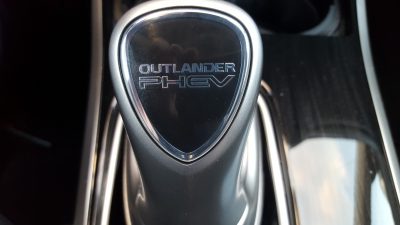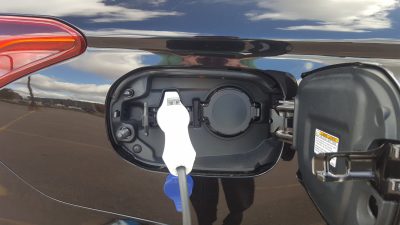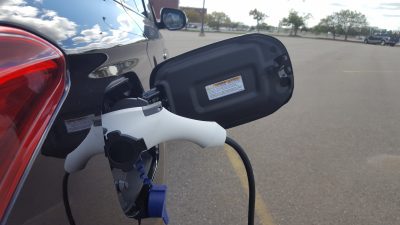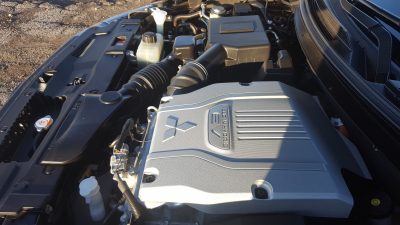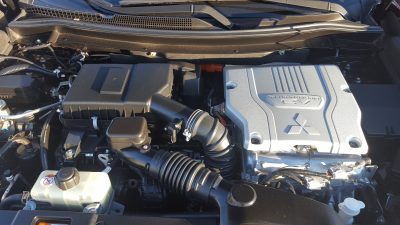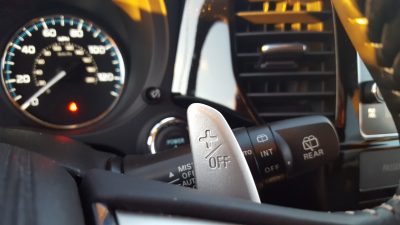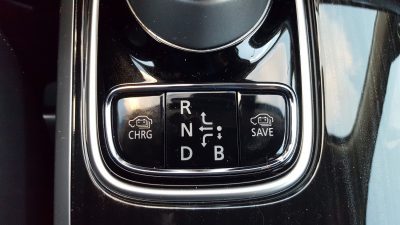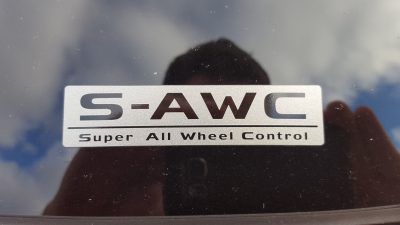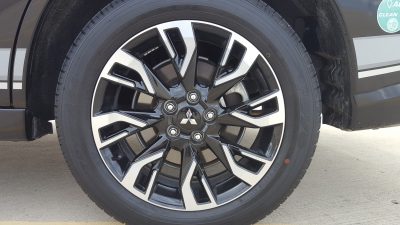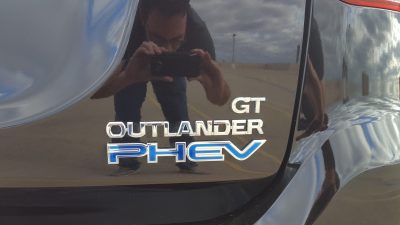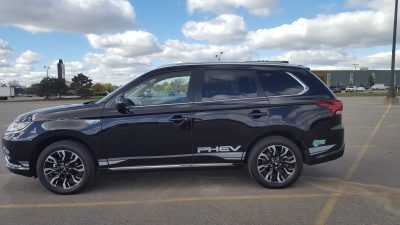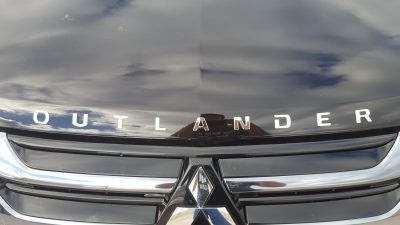When we last met the Mitsubishi Outlander, it was in its base 2.4 liter form and it proved to be a very reliable steed, with the one we had impressing us with its Prius like fuel economy on a summer road trip from our Metro Detroit office to Wisconsin for a press association event. But what if your an SUV buyer who thinks even this insane display of fuel economy isn’t enough for your needs? Mitsubishi has you covered with the all new Outlander PHEV. But does it retain some of the subtle charms that allowed its four cylinder counterpart to crawl its way into a well deserved spot in our hearts? or has it lost some of its basic virtues in the quest for even more fuel economy?
Budget Focused Style:
When viewed alongside its pure gasoline powered cousin, the Outlander PHEV shares a lot of the same basic DNA that has defined the Outlander lineup as a whole. Like our last Outlander encounter, the PHEV model Mitsubishi let us try featured a black on black motif despite it not being an “LE” badged car. The front fascia is still distinctively Mitsubishi, with a bold front grille and somewhat sporty intentions that don’t translate to the bland rear end. Like before, the design is a case of function over form, but look for that to not necessarily put off potential buyers that gravitate towards such things. The one item that might however, are the garish stickers that adorned the sides of our tester.
Like a neon emblazoned billboard, they boldly advertised the eco friendly capabilities of our tester, and were on top of the bright blue PHEV badging that already adorned the rear liftgate and fenders. General Motors utilized a similar strategy when they unleashed hybrid versions of their SUVs (Chevrolet Tahoe, GMC Yukon, and Cadillac Escalade) and like those past offerings, the graphics rob the Outlander of its ability to be more discrete when out on the road. Thankfully, they are a $285 option, and we suspect that the bulk of buyers will prefer a less shouty suit of clothes on their Outlander purchase. That said, we hope to see a more comprehensive styling update now that Nissan has a significant stake in the company. The Outlander is falling behind rivals in aesthetics, and lacks the polish that we have come to expect in many of the current crop of SUV models that are clamoring for buying attention in a crowded sea of entries.
A Three Row SUV, Without The Third Row?
You read that correctly, the Outlander PHEV does not have a third row seat even though it is based on the three row version of the Outlander. This odd quirk is due to engineering needs, with the missing seats being pitched to make room for the 12 kWh lithium ion battery pack, which is neatly placed in the area behind the second row. This placement as well as clever storage areas, allows the Outlander PHEV to have a flat cargo floor, with the PHEV only losing a couple cubic feet of cargo space when compared to the traditional Outlander. Curiously, there are still cupholder inserts in certain parts of the emptied third row, which can hold cups of ectoplasm for the ghosts of the third row passengers.
The rest of the interior is based on the Outlander GT, and while it still lacks the polish that defines the Platinum and Touring trims offered by its rivals, there are some good highlights that make themselves apparent. The leather seats in our tester were very comfortable, and our tester offered good amounts of front leg room. Cheap plastics are still abundant, but we did not encounter any ill fitting pieces of trim, and the power seats in our tester were a welcome improvement over manual adjustments. The nifty touchscreen infotainment system looked great, but some of the baked in controls were not easy to figure out at first glance. The screen has three different pages to swipe through, and three different “settings” icons with some features being accessed though redundant controls near the drivers left knee versus the steering wheel mounted controls. Ergonomic quirks aside, we did appreciate the automatically folding rear headrests in the 60/40 rear split seats, which helped take some of the muscle out of folding them up and down, with the seats still forcing drivers to fold the bottom cushion forward to get the rear seatbacks down. The leather wrapped steering wheel featured big paddles, but unlike traditional paddle shifters, the units here do not shift the gears. Instead, they control how aggressively the regeneration system kicks in when cruising. This particular setup is a nice homage to the Evo, but it also makes us miss it even more too.
Electrified Versatility:
Performance for the 2018 Mitsubishi Outlander has never been a strong suit, and that established trait continues with the Outlander PHEV. What it lacks in agility, it makes up for in versatility, with the 2.0 liter four cylinder and the hybrid powertrain working together to drive the front wheels, with a second rear mounted electric motor controlling the rear wheels. Combined system output is 197 horsepower, and it allowed our tester to have an impressive degree of security and poise when taken through the daily commute and also in city driving. When we took our tester out on the freeway, some of this poise was lost, but the combined output still allowed our tester to have good passing manners. The Outlander PHEV also has the ability to function on pure electric power, and this allowed our tester to impress us with its quiet acceleration, though vigorous driving does eat into its already small 33 mile pure EV driving range.
But as mentioned earlier, versatility is the name of the game here, and the Outlander PHEV impressed us in this regard. Currently the Outlander PHEV is the only plug-in all-wheel drive SUV in the market (that will change with the introduction of the Lincoln Aviator GT) but for now, the Outlander doesn’t have to share its unique niche of the SUV market with others. Mitsubishi claims that owners can charge from either fast charging sources or 120-volt and 240-volt power outlets. But with the hilariously sized power converter box being too big for our garage based charging location, we instead opted to use the 2.0 liter four cylinder engine as a generator for the bulk of our charging needs. This alternative method allows the battery to gradually recharge while on the move or at idle, and it is designed to help provide a charge when a plug isn’t available. The lone tradeoff is that fuel economy does dip a bit when this particular charging mode is used. With all of this adaptability, it was a pity that the fuel economy of the 2.0 liter fell short of some entries once the battery is fully depleted. The increased weight of the electrification technology as well as a smaller fuel tank makes the PHEV produce 25 mpg, which is slightly worse than a regular all-wheel drive equipped four cylinder Outlander and its 26 mpg, meanwhile, the non plug-in Toyota RAV4 Hybrid achieves 32 mpg in combined driving.
Handling is about what you would expect from an offering like this with our tester feeling secure, but not providing much in terms of overall handling excitement. While scheduling prevented us from doing a repeat road trip like we did with its pure gasoline sibling, we opted for the next best thing, and embarked on a trip down to Ohio to surprise Emily’s grandpa with a visit. Navigating some of the streets and boulevards that dotted Toledo allowed us to experience just how surprisingly plush the Outlander PHEV is with minimal body roll and not as much nose dive as we initially expected. Our tester also proved easy to park at Hollywood Casino later in the day, where our wallets left empty, but the battery had ample levels of charge for our trip home.
Value Quotient:
As mentioned earlier, the 2018 Outlander PHEV brings a balanced degree of luxury and everyday usability to budget focused consumers. While the $40,295 base price may seem a bit steep at first glance, the PHEV variant does qualify for a $5,826 federal tax credit, which excludes any incentives offered at the state level. Factor this into the money equation, and our $42,225 tester ends up being in the mid $35,000 region in price. This allows the Outlander PHEV to be in a unique position, with it being the only conventionally styled plug-in SUV you can get for this amount. The Chevy Bolt and the Hyundai Kona EV can pull a similar feat, but both of them are smaller CUVs, and lack the Outlander’s larger size and capability. The gasoline only Outlander GT starts at $32,245, and that serves to enhance the welcoming compromise that the Outlander PHEV brings to the festivities.
While the 2018 Outlander lineup is still mainly on the outside looking in when it comes to the ever growing SUV segment, Mitsubishi is making small changes to try and give the Outlander a fighting chance. The introduction of the Outlander PHEV does allow Mitsubishi to further enhance their drive towards being a green minded SUV company, and with the expanding adoption of electrification and hybrid technology in the SUV segment, the Outlander is in a good position to be a future disruptor in the marketplace, especially if it receives the right combination of exterior, interior, and hardware updates from new partner Nissan.

Carl Malek has been an automotive journalist for over 10 years. First starting out as a freelance photographer before making the transition to writing during college, his work has appeared on numerous automotive forums as well as websites such as Autoshopper.com.
Carl is also a big fan of British vehicles with the bulk of his devotion going to the Morgan Motor Company as well as offerings from Lotus, MG, and Caterham. When he is not writing about automobiles, Carl enjoys spending time with his family and friends in the Metro Detroit area, as well as spending time with his adorable pets.

